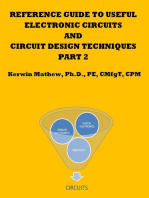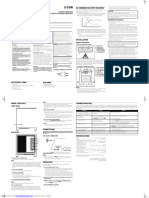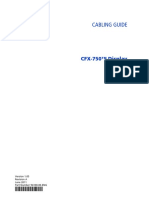0%(1)0% found this document useful (1 vote)
167 viewsCommutation Methods SCR PDF
Commutation Methods SCR PDF
Uploaded by
Nate1. There are different methods for turning off an SCR, either natural commutation which relies on reverse voltage or forced commutation which uses external circuits.
2. Forced commutation methods are classified based on whether they use a voltage pulse or current pulse and whether components are connected in parallel or series with the SCR.
3. Common forced commutation methods include Class A which uses a voltage pulse, Class B which uses a self-commutated L-C circuit, and Class C which uses a switched C or L-C circuit.
Copyright:
© All Rights Reserved
Available Formats
Download as PDF, TXT or read online from Scribd
Commutation Methods SCR PDF
Commutation Methods SCR PDF
Uploaded by
Nate0%(1)0% found this document useful (1 vote)
167 views2 pages1. There are different methods for turning off an SCR, either natural commutation which relies on reverse voltage or forced commutation which uses external circuits.
2. Forced commutation methods are classified based on whether they use a voltage pulse or current pulse and whether components are connected in parallel or series with the SCR.
3. Common forced commutation methods include Class A which uses a voltage pulse, Class B which uses a self-commutated L-C circuit, and Class C which uses a switched C or L-C circuit.
Original Description:
Commutation-methods-scr-pdf
Original Title
Commutation Methods Scr PDF
Copyright
© © All Rights Reserved
Available Formats
PDF, TXT or read online from Scribd
Share this document
Did you find this document useful?
Is this content inappropriate?
1. There are different methods for turning off an SCR, either natural commutation which relies on reverse voltage or forced commutation which uses external circuits.
2. Forced commutation methods are classified based on whether they use a voltage pulse or current pulse and whether components are connected in parallel or series with the SCR.
3. Common forced commutation methods include Class A which uses a voltage pulse, Class B which uses a self-commutated L-C circuit, and Class C which uses a switched C or L-C circuit.
Copyright:
© All Rights Reserved
Available Formats
Download as PDF, TXT or read online from Scribd
Download as pdf or txt
0%(1)0% found this document useful (1 vote)
167 views2 pagesCommutation Methods SCR PDF
Commutation Methods SCR PDF
Uploaded by
Nate1. There are different methods for turning off an SCR, either natural commutation which relies on reverse voltage or forced commutation which uses external circuits.
2. Forced commutation methods are classified based on whether they use a voltage pulse or current pulse and whether components are connected in parallel or series with the SCR.
3. Common forced commutation methods include Class A which uses a voltage pulse, Class B which uses a self-commutated L-C circuit, and Class C which uses a switched C or L-C circuit.
Copyright:
© All Rights Reserved
Available Formats
Download as PDF, TXT or read online from Scribd
Download as pdf or txt
You are on page 1of 2
Commutation methods scr pdf
Commutation methods scr pdf
Commutation methods scr pdf
DOWNLOAD!
DIRECT DOWNLOAD!
Commutation methods scr pdf
Requirements to be satisfied for the successful turn-off of a SCR. Iv Design of a SCR commutation circuit. Classification of forced
commutation methods.The commutation process plays an important role in the operation and control of both naturally commutated
or line commutated and forced commutated SCR.Abstract-A classification of thyristor commutation methods is presented. The
classification is based on whether the commutation pulse is a voltage pulse or.SCR 800 V in series in order to generate a high
voltage device 1600 V. Forced commutation methods for turningoff the SCRs.
commutation methods of scr pdf
Inverse Parallel.These methods of turn-off do not refer to those cases where the anode current.
commutation methods scr
Once the SCR is turned ON, it remains ON even after removal of the gate signal.devices power conversion techniques have been
introduced.The power. Forced-commutated Thyristors Inverter grade Thyristors. Classification of thyristor commutation
techniques is based on either voltage or current pulse and connected in parallel or serial with thyristor. Classification of forced
commutation methods 2. Class B, Self commutated by an L-C circuit 3.
commutation methods of scr.ppt
Class C, C or L-C switched by. GautamAKGEC, Ghaziabad.SCR turn off methods Natural commutation Forced commutation-
Class A. may be thyristor circuits used in many power supply applications. Commutation of Thyristor or Silicon Controlled
Rectifier: Commutation is the process by which we can turn OFF a thyristor. Commutation.process of turning OFF SCR.reverse
voltage is applied across the thyristor during the turn OFF process.Natural Commutation.
forced commutation methods of scr
The turning on Process of the SCR is known as Triggering. In other words, turning the. Read More: Thyristor: Turn-
OffCommutation methods3 Apr 2010. Thyristor Commutation Techniques with ckts and discription.An SCR rated about 100
amperes, 1200 volts mounted on a heat sink - the two small wires are the gate trigger leads. This method is called forced
commutation.
Jan 11, 2013.
Current Transmission - Proven Technology for Power Exchange PDF.also commutated in a similar manner because the gate is
ineffective to achieve commutation. Voltage in reverse to the outgoing thyristor, which is commutated.
commutation techniques of scr pdf
Therefore this technique creates what may be called. There are three methods of switching off the SCR, namely natural
commutation. With an SCR to turn-off the SCR is called forced commutation.From the point of view of the commutation process,
they can be classified in two important categories: Line Commutated Controlled Rectifiers Thyristor.Requirements to be satisfied for
the successful turn-off of a SCR. Inverse Parallel.Sep 2, 2014. Classification of thyristor commutation techniques is based on either
voltage or current pulse and connected in parallel or serial with thyristor.Jan 11, 2013. Commutation.process of turning OFF
SCR.reverse voltage is applied across the thyristor during the turn OFF process.Natural Commutation.devices power conversion
techniques have been introduced.The power.
With an SCR to turn-off the SCR is called forced commutation.
Line-commutated.ii Forced commutation. The method of discharging a capacitor in parallel with an SCR to turn off the SCR is
called forced commutation. 11 shows the.May 2, 2013.
DOWNLOAD!
DIRECT DOWNLOAD!
You might also like
- SCS, Lascr, Diac and TriacDocument16 pagesSCS, Lascr, Diac and TriacRyan Paul RiwarinNo ratings yet
- Commutation Techniques of SCR PDFDocument2 pagesCommutation Techniques of SCR PDFLeasaNo ratings yet
- Commutation Methods of SCR PDFDocument2 pagesCommutation Methods of SCR PDFDanielle0% (1)
- Commutation of SCR PDFDocument2 pagesCommutation of SCR PDFMichaelNo ratings yet
- Commutation Circuits SCR PDFDocument2 pagesCommutation Circuits SCR PDFRhondaNo ratings yet
- Commutation Circuits of SCR PDFDocument2 pagesCommutation Circuits of SCR PDFBrianNo ratings yet
- U5 l35 Thyristor Commutation TechniquesDocument3 pagesU5 l35 Thyristor Commutation TechniqueskaushalNo ratings yet
- Silicon Controlled Rectifier (SCR) - Electrical4uDocument5 pagesSilicon Controlled Rectifier (SCR) - Electrical4uMahesh Kumar BhattaNo ratings yet
- Thyristor Commutation TechniquesDocument3 pagesThyristor Commutation Techniquesตะวันแดงปากน้ำโพNo ratings yet
- Classification of Thyristor Commutation TechniquesDocument11 pagesClassification of Thyristor Commutation TechniquesUmar MurtazaNo ratings yet
- Commutation Circuits PDFDocument2 pagesCommutation Circuits PDFRalph0% (1)
- Basic Electronics (18ELN14/18ELN24) - Silicon Controlled Rectifier (Module 2)Document5 pagesBasic Electronics (18ELN14/18ELN24) - Silicon Controlled Rectifier (Module 2)Shrishail BhatNo ratings yet
- Pe PPT PDFDocument268 pagesPe PPT PDFtushar agale100% (1)
- SCR's PresentationDocument27 pagesSCR's PresentationRaveesh RahulNo ratings yet
- Indus Lecture 2 PartialDocument69 pagesIndus Lecture 2 PartialIris Jean Mosquera100% (1)
- Power ElectronicsDocument11 pagesPower ElectronicsRAHUL MOINo ratings yet
- SCR Silicon Controlled Rectifier: Time (TQ)Document4 pagesSCR Silicon Controlled Rectifier: Time (TQ)Daniela Cardenas LuboNo ratings yet
- SCR NotesDocument4 pagesSCR Notesmathew_john0077393100% (1)
- SCR Turn OFF Methods PDFDocument15 pagesSCR Turn OFF Methods PDFTariq Ali33% (3)
- Industrial Automation AssignmentDocument9 pagesIndustrial Automation AssignmentChandan ChandanNo ratings yet
- Experiment #10-Using SCRS: Hands-On RadioDocument2 pagesExperiment #10-Using SCRS: Hands-On RadioAnonymous ptCa270Uy2No ratings yet
- RMAE Notes SCRDocument9 pagesRMAE Notes SCRPriyanka BhateleNo ratings yet
- $$$.introduction To Power Electronics PDFDocument445 pages$$$.introduction To Power Electronics PDFFaeez Izzham100% (1)
- Commutation Techniques 1Document19 pagesCommutation Techniques 1Nataraju Gandla60% (5)
- Natural or Line Commutation - Principle With Circuit Diagram - Electrical ConceptsDocument3 pagesNatural or Line Commutation - Principle With Circuit Diagram - Electrical ConceptsMohammad HamamdNo ratings yet
- SCR Applications NotesDocument14 pagesSCR Applications NotesShyleshNo ratings yet
- Problem Solve of Indutrial Electronics FinalDocument9 pagesProblem Solve of Indutrial Electronics FinalMd Raton AliNo ratings yet
- Silicon Controlled RectifierDocument1 pageSilicon Controlled RectifierJazzel Avila ParadiseNo ratings yet
- Power Ca1Document14 pagesPower Ca1gamerindianpartime2003No ratings yet
- Learning OutcomesDocument51 pagesLearning Outcomesdimpisingh004No ratings yet
- Submitted by:-MANOJ EL-4300-2K16Document28 pagesSubmitted by:-MANOJ EL-4300-2K16Bhupender Kumar MahurNo ratings yet
- Color Organ: As Minor Project Under The Supervision ofDocument6 pagesColor Organ: As Minor Project Under The Supervision ofShivank ShuklaNo ratings yet
- Special Devices or Breakdown DevicesDocument13 pagesSpecial Devices or Breakdown DevicesMuhammad Arif Rattar100% (1)
- AEE311L Experiment 7 8Document8 pagesAEE311L Experiment 7 8Fe BaltazarNo ratings yet
- Thyristors Sec B Power ElectronicsDocument38 pagesThyristors Sec B Power ElectronicsFederico AldoNo ratings yet
- Thyristor & Power Control CircuitsDocument5 pagesThyristor & Power Control CircuitsMani100% (1)
- Notes On ID VFDDocument1 pageNotes On ID VFDAvik BhattacharyaNo ratings yet
- AST 117 - Industrial Power ElectronicsDocument25 pagesAST 117 - Industrial Power ElectronicsKrieczek DoyuganNo ratings yet
- SCRDocument30 pagesSCRRaghav Gupta100% (4)
- Power UNIT I PDFDocument39 pagesPower UNIT I PDFNoor WaleedNo ratings yet
- What Is Power Electronics?Document3 pagesWhat Is Power Electronics?MouliNo ratings yet
- Commutation Techniques PDFDocument2 pagesCommutation Techniques PDFBonnieNo ratings yet
- Chapter 1 Content APP&A-1Document15 pagesChapter 1 Content APP&A-1sm7526359No ratings yet
- Special Semiconductor Devices: Mr. Jay Mehta Asst. Professor St. Francis Institute of TechnologyDocument35 pagesSpecial Semiconductor Devices: Mr. Jay Mehta Asst. Professor St. Francis Institute of Technologyjay mehtaNo ratings yet
- L - 8 LINE COMMUTATION Self and Forced CommutationDocument13 pagesL - 8 LINE COMMUTATION Self and Forced CommutationevansNnyingeNo ratings yet
- Flow in One Direction and Opposes It in Another Direction. SCR Has Three TerminalsDocument6 pagesFlow in One Direction and Opposes It in Another Direction. SCR Has Three TerminalsEdelson Mark GarciaNo ratings yet
- Thyristor: Silicon Controlled Rectifier (SCR)Document9 pagesThyristor: Silicon Controlled Rectifier (SCR)Vlad V WalachiaNo ratings yet
- Ee2301 - Power Electronics: Om SathiDocument15 pagesEe2301 - Power Electronics: Om SathiNavneeth50% (6)
- EEN-324 Power ElectronicsDocument53 pagesEEN-324 Power ElectronicsRameshBabuNo ratings yet
- Design of Snubber Circuit Using PspiceDocument4 pagesDesign of Snubber Circuit Using Pspiceelpatotas22No ratings yet
- RC Snubber Circuit Design For Thyristor Using Turn-Off Model in PspiceDocument5 pagesRC Snubber Circuit Design For Thyristor Using Turn-Off Model in PspiceIjsrnet EditorialNo ratings yet
- Simulation of Power Electronic Converters Using Matlab SimulinkDocument19 pagesSimulation of Power Electronic Converters Using Matlab SimulinkajithNo ratings yet
- Introduction To Power ElectronicsDocument68 pagesIntroduction To Power ElectronicsLovely CastilloNo ratings yet
- L8 Controlled Rectifier (Part1)Document12 pagesL8 Controlled Rectifier (Part1)mohamedsamy9878No ratings yet
- Turn Off Methods For SCRDocument31 pagesTurn Off Methods For SCRsrinivas gangishettiNo ratings yet
- Silicon Controlled Rectifier (SCR) Lecture - 16Document31 pagesSilicon Controlled Rectifier (SCR) Lecture - 16evansNnyingeNo ratings yet
- Eee421: Power Electronics: Power Semiconductor Devices: ThyristorDocument20 pagesEee421: Power Electronics: Power Semiconductor Devices: ThyristorRafat ShamsNo ratings yet
- Module 2 (B) Thyristor Commutation TechniquesDocument42 pagesModule 2 (B) Thyristor Commutation TechniquesK N DEEPSHINo ratings yet
- Power Electronics-2 MarksDocument12 pagesPower Electronics-2 Marks20EUEE053- MADHUBALAN.SNo ratings yet
- Reference Guide To Useful Electronic Circuits And Circuit Design Techniques - Part 2From EverandReference Guide To Useful Electronic Circuits And Circuit Design Techniques - Part 2No ratings yet
- Gabbiano Ultralight RadarDocument2 pagesGabbiano Ultralight RadarVictor PileggiNo ratings yet
- Historical Development of Television in PakistanDocument5 pagesHistorical Development of Television in PakistanJust listenNo ratings yet
- InternrepDocument14 pagesInternrepEden AdmasuNo ratings yet
- PhotodetectorsDocument2 pagesPhotodetectorsstefan adrianNo ratings yet
- Inspiron 3647Document15 pagesInspiron 3647duadayNo ratings yet
- Deity Connect Manual ENDocument1 pageDeity Connect Manual ENszuperbandi2No ratings yet
- SKU: OSD-AP650: 6.5" High Performance Outdoor Patio 2-Way Speaker Pair W/ Optional 70V, Color: White or BlackDocument2 pagesSKU: OSD-AP650: 6.5" High Performance Outdoor Patio 2-Way Speaker Pair W/ Optional 70V, Color: White or BlackMohammad FamuNo ratings yet
- Radio Electronics November 1991 PDFDocument188 pagesRadio Electronics November 1991 PDFlivslx100% (1)
- H.264 DVR User's ManualDocument63 pagesH.264 DVR User's ManualDarthRevan23No ratings yet
- Important: in Combination With SpeakersDocument2 pagesImportant: in Combination With SpeakerskalyanammisettyNo ratings yet
- BC337-16 BC337-25: NPN General Purpose AmplifierDocument4 pagesBC337-16 BC337-25: NPN General Purpose AmplifierAmirNo ratings yet
- PmicDocument80 pagesPmicJoão FerreiraNo ratings yet
- Introduction To ASIC Design: Dr. Paul D. Franzon Genreal OutlineDocument54 pagesIntroduction To ASIC Design: Dr. Paul D. Franzon Genreal OutlineMohammed El-AdawyNo ratings yet
- Dela Cruz, Mark Adrian R. ECE 114 Assignment #1 Midterm: Schematic DiagramDocument11 pagesDela Cruz, Mark Adrian R. ECE 114 Assignment #1 Midterm: Schematic DiagramEmil Eugene DomingoNo ratings yet
- 1.5v Battery ChargerDocument25 pages1.5v Battery ChargerJOHN BRICCO A. MATACSILNo ratings yet
- ST47-Groundhog Rev-E US EnglishDocument4 pagesST47-Groundhog Rev-E US EnglishErick VillegasNo ratings yet
- El Sema 330Document6 pagesEl Sema 330Golbert GolbiNo ratings yet
- Channel Coding TechniquesDocument6 pagesChannel Coding TechniquesBindia SahuNo ratings yet
- Chapter 05 Analog TransmissionDocument63 pagesChapter 05 Analog TransmissionSameer HmedatNo ratings yet
- Cat. N12u01 AhDocument2 pagesCat. N12u01 AhJuan NaranjoNo ratings yet
- CFX CG 94100-00-Eng 105a Aw PDFDocument78 pagesCFX CG 94100-00-Eng 105a Aw PDFEdwin Melendez0% (1)
- Army Robot PDFDocument3 pagesArmy Robot PDFRajeevNo ratings yet
- 09 - 5780 - Embedded System Design L1 - 2upDocument9 pages09 - 5780 - Embedded System Design L1 - 2upashish_phoenix10No ratings yet
- DC To AC Converters PDFDocument4 pagesDC To AC Converters PDFrizwanNo ratings yet
- MB Manual Ga-78lmt-S2p v.5.0 eDocument44 pagesMB Manual Ga-78lmt-S2p v.5.0 ePit LazicNo ratings yet
- VDBDocument45 pagesVDBViaNo ratings yet
- US Patent 2015 Method and Circuit For Detecting USB3.0 LFPS SignalDocument12 pagesUS Patent 2015 Method and Circuit For Detecting USB3.0 LFPS SignalVăn Phú HảiNo ratings yet
- 82 Review of Control Techniques For Inverters Parallel OperationDocument11 pages82 Review of Control Techniques For Inverters Parallel Operationamina bu bakerNo ratings yet
- L2CN :network Layers and Physical LayerDocument12 pagesL2CN :network Layers and Physical LayerAhmad ShdifatNo ratings yet
- Operational AmplifierDocument7 pagesOperational Amplifiermothaffar ahmadNo ratings yet

























































































